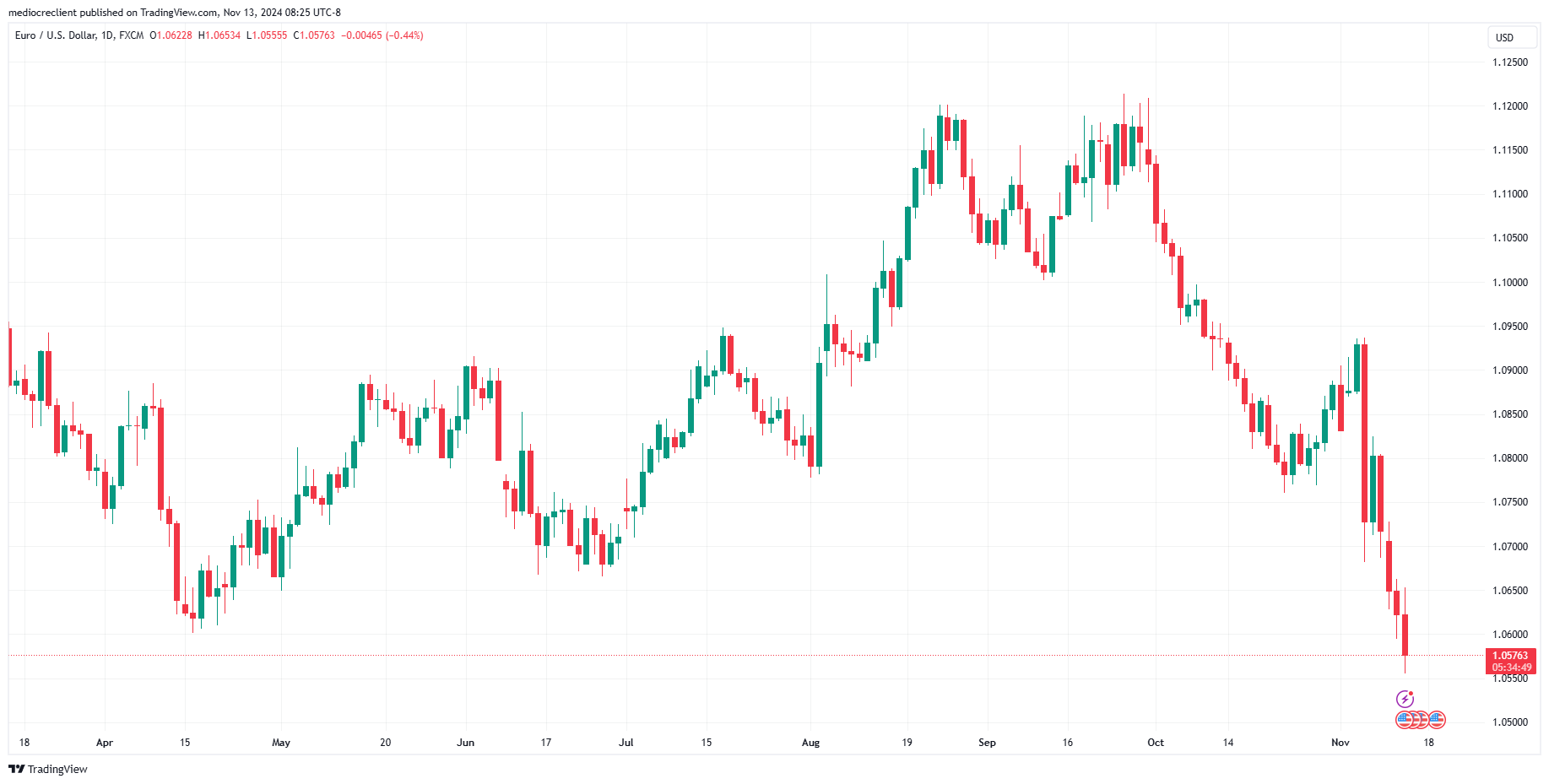EUR/USD finds a new year-long low as Euro continues to corrode
- EUR/USD slipped below 1.0600 on Wednesday, heading into 1.0550.
- A brief recovery off the back of US CPI inflation is unlikely to hold.
- Euro is set to close in the red against the Greenback for a fourth straight day.
EUR/USD continued to backslide on Wednesday, falling into 1.0550 and finding only a meager bounce from 54-week lows after US Consumer Price Index (CPI) inflation for October printed closely to median market forecasts. The Euro continues to shed fans as market participants struggle to find reasons to bid Fiber, leaving EUR/USD at the mercy of broad-market US Dollar flows.
US CPI inflation for October came in broadly as-expected on Wednesday, however final figures failed to make any progress toward cooling targets, and key annual measures accelerated on a yearly basis. US CPI rose 0.2% MoM in October, in-line with the previous month’s inflation print, while ‘supercore’ CPI for the year ended in October rose 4.37% YoY compared to the previous period’s print of 4.26%.
The US Dollar eased slightly post-CPI, giving Fiber a chance to recover its stance from year-long lows, however momentum remains thin as global markets broadly focus on US labor figures to spark further rates cuts from the Federal Reserve (Fed).
EUR/USD price forecast
With the Euro testing 54-week lows against the Greenback, the pressure is on for bidders to find a floor and push off from it before things decay to the point that EUR/USD backslides below the technical floor priced in near 1.0500. It’s been a sharp turnaround in Fiber bids this year: just seven weeks ago, the Euro had set a year-plus high against the US Dollar just shy of 1.1300.
EUR/USD daily chart
Euro FAQs
The Euro is the currency for the 19 European Union countries that belong to the Eurozone. It is the second most heavily traded currency in the world behind the US Dollar. In 2022, it accounted for 31% of all foreign exchange transactions, with an average daily turnover of over $2.2 trillion a day. EUR/USD is the most heavily traded currency pair in the world, accounting for an estimated 30% off all transactions, followed by EUR/JPY (4%), EUR/GBP (3%) and EUR/AUD (2%).
The European Central Bank (ECB) in Frankfurt, Germany, is the reserve bank for the Eurozone. The ECB sets interest rates and manages monetary policy. The ECB’s primary mandate is to maintain price stability, which means either controlling inflation or stimulating growth. Its primary tool is the raising or lowering of interest rates. Relatively high interest rates – or the expectation of higher rates – will usually benefit the Euro and vice versa. The ECB Governing Council makes monetary policy decisions at meetings held eight times a year. Decisions are made by heads of the Eurozone national banks and six permanent members, including the President of the ECB, Christine Lagarde.
Eurozone inflation data, measured by the Harmonized Index of Consumer Prices (HICP), is an important econometric for the Euro. If inflation rises more than expected, especially if above the ECB’s 2% target, it obliges the ECB to raise interest rates to bring it back under control. Relatively high interest rates compared to its counterparts will usually benefit the Euro, as it makes the region more attractive as a place for global investors to park their money.
Data releases gauge the health of the economy and can impact on the Euro. Indicators such as GDP, Manufacturing and Services PMIs, employment, and consumer sentiment surveys can all influence the direction of the single currency. A strong economy is good for the Euro. Not only does it attract more foreign investment but it may encourage the ECB to put up interest rates, which will directly strengthen the Euro. Otherwise, if economic data is weak, the Euro is likely to fall. Economic data for the four largest economies in the euro area (Germany, France, Italy and Spain) are especially significant, as they account for 75% of the Eurozone’s economy.
Another significant data release for the Euro is the Trade Balance. This indicator measures the difference between what a country earns from its exports and what it spends on imports over a given period. If a country produces highly sought after exports then its currency will gain in value purely from the extra demand created from foreign buyers seeking to purchase these goods. Therefore, a positive net Trade Balance strengthens a currency and vice versa for a negative balance.
